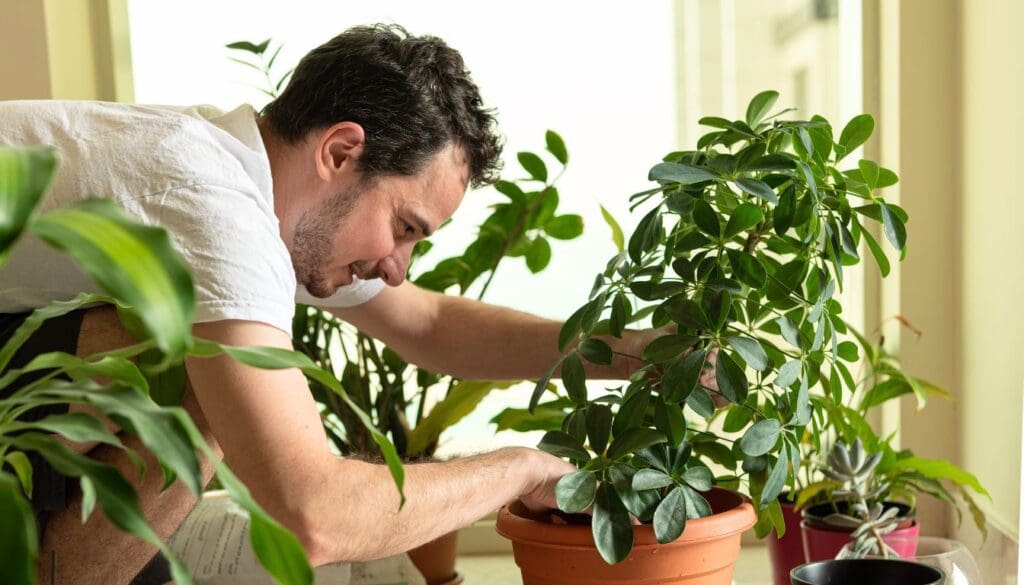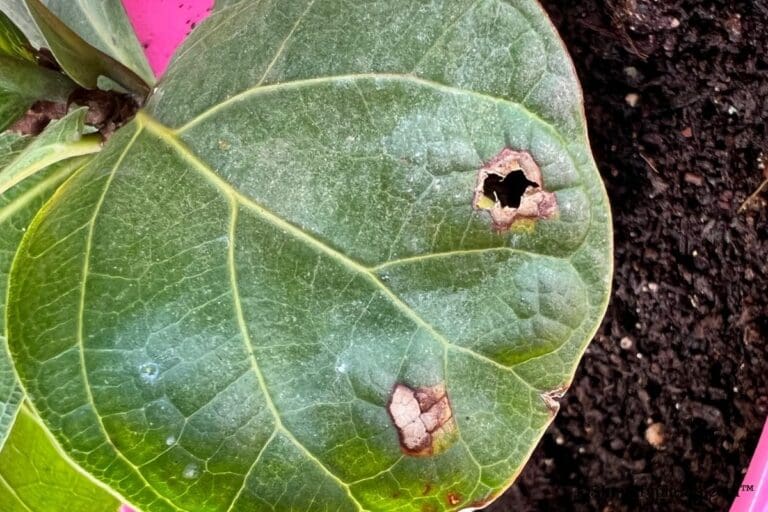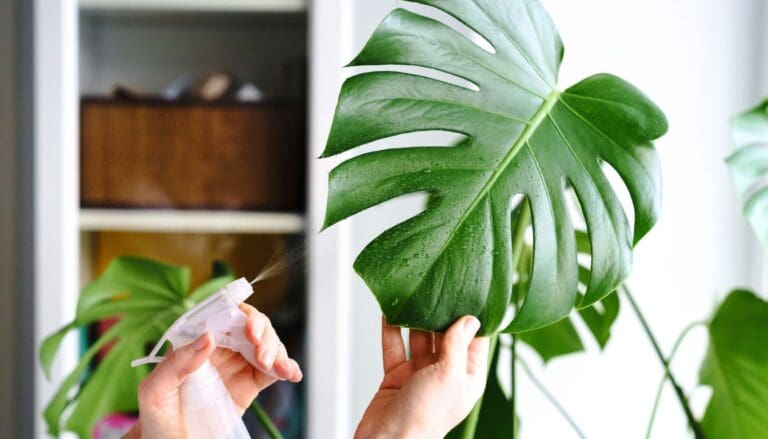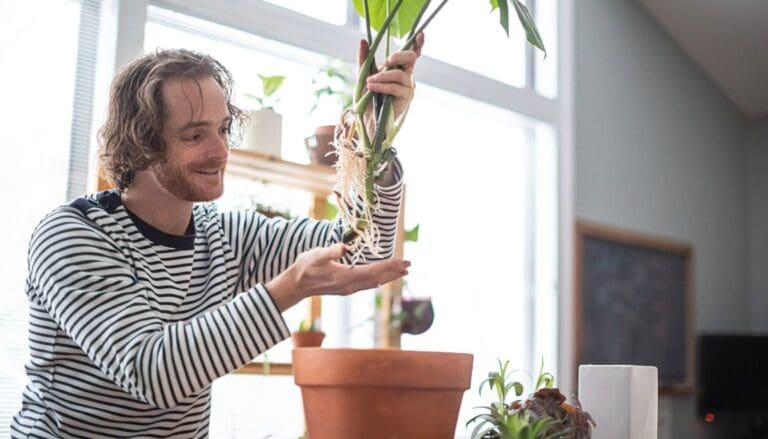9 Reasons Why Your Schefflera Is Turning Brown
Schefflera plants, popularly known as umbrella plants, are one of the most lovable houseplants as they are fairly easy to grow and take care of. However, it is disheartening to find brown leaves on your Schefflera plant.
The common reasons for brown leaves in Schefflera are overwatering, extreme temperatures, sunburn, and over-fertilization. To fix the issue, ensure you water the plant when the top soil is dry, keep them at moderate temperature away from direct light and fertilize the plant as necessary.
Brown leaves on Schefflera is a sign that you have missed the initial stages of the problem, and now you must act fast to fix it.
In this article, I will discuss all the possible reasons that cause brown leaves in Schefflera, along with their fixations.

Please note: Simplify Plants is reader-supported. Some links in the post are affiliate links and I get a commission from purchases made through links in the post.
Is it normal for Schefflera to get brown leaves?
Yes, it is normal for Schefflera to get brown leaves.
Schefflera leaves, like any other plant, will turn brown at the end of their life cycle, and this process is natural aging.
The older leaves first turn yellow and then brown as they age.
Schefflera will shed old leaves as a sign of natural aging, and these leaves will give their place to the newborn leaves.
The bottom of the plant mainly has these leaves, and you can prune them to encourage new growth.
However, if you notice that the entire plant has started turning brown and stopped growing, the underlying cause is something else.
In such a case, you must carefully observe your Schefflera, find the reason for the brown leaves, and work on fixing them.
Why are my umbrella leaves turning brown?
Umbrella plants have small, green glossy leaves, sometimes with creamy variegation.
However, the leaves will get discolored if they don’t receive a suitable growing environment.
Maintaining the growing conditions similar to their natural habitat can be tricky, and this is when the problem arises.
It is essential to identify the causes behind discoloration earlier to fix the plant before it is too late.
Below I have listed some of the reasons that cause brown leaves in Schefflera, which are:
- Overwatering
- Poor drainage
- Underwatering
- Direct sunlight
- Insufficient light
- Low humidity
- Chemical sensitivity
- Overfertilization
- Pest infestation
- Diseases
Let us now discuss all the above points in detail.
Overwatering

Schefflera are hardy plants and will not die if they are overwatered every once in a while.
However, if you continue to overwater your Schefflera for a prolonged period, their roots will begin to rot, and their leaves will turn brown and fall off.
Consistent overwatering will keep the roots saturated with water, which will lead to root rot.
Damaged roots will fail to supply water and nutrients to the plant, which causes them to become unstable.
Their leaves will droop, turn brown, and fall off.
Solution:
- Check the root system if you have overwatered your umbrella plant. If the roots look healthy, you can spread the soil covering the roots under bright sunlight to let them dry.
- If the roots have turned mushy and brown, prune them off and keep only the healthy ones. Repot the plant in fresh and nutrient-rich soil after cleaning the healthy roots with fungicide.
- Allow the plant to recover from stress before you resume watering.
- Before watering Schefflera, check the moisture level of the soil. If the first 2 cm of the soil feels damp, wait for a few days until the soil dries. Water the plant only when 50-75% of the soil volume is dry.
- You can also use a moisture meter to keep an eye on the soil’s moisture level.
Also read: How To Save An Overwatered Schefflera? (Signs, Causes & Fix)
Poor soil drainage
A poorly drained soil can create a situation of both overwatering and underwatering.
If you are using too compact soil, it will retain moisture for a longer period, which will hamper the root system, leading to brown leaves.
Also, if you use soil that drains fast and fails to retain enough moisture, the plant will experience dehydration and show brown leaves.
Solution:
- If the soil is too tight and compact, add perlite, sand, and compost to improve drainage.
- If the soil is too loose, you can increase its moisture retention capacity by adding peat moss, mulch, or vermiculite.
Also read: What Kind Of Soil Does A Schefflera Plant Need? (+Ideal DIY Soil Mix)
Underwatering

Underwatering can occur if you do not remember when to water your plant or if you are watering it at irregular intervals.
A prolonged drought condition will seriously impact your Schefflera’s health.
If your plant’s soil has dried out completely, you may notice the leaves turning droopy, crispy, curly, and possibly brown.
Due to a lack of sufficient moisture, the leaves will get dehydrated and will not be able to carry out various life processes leaving the plant extremely weak and pale.
Solution:
- If the soil feels extremely dry, water your plant a little bit every day. Do not give the plant plenty of water at once. Otherwise, the water will drain out without soaking the entire soil.
- You can also keep your plant in a sink with 3-4 inches of water. Allow the plant to soak up water through the drainage holes in the pot for 30 minutes. Check the soil and if it feels damp, drain off the excess water present in the sink and allow the plant to rest while it drains thoroughly.
- If you forget to water your plant, you can set a reminder on your phone to keep track of your plant’s watering habits.
- You can also use a self-watering pot to reduce the chances of underwatering.
Also read: How Much Water Does A Schefflera Plant Need? (Watering Guide)
Direct sunlight
Schefflera are indoor plants that can’t tolerate direct sunlight.
They prefer to grow in bright indirect light, and exposure to direct sunlight is one of the most common causes of brown leaves.
This condition is a sign of sunburn or sunscald, and you will find that the edges of the leaves are turning brown first before the whole leaf turns brown.
The sun’s direct rays increase the evaporation rate, which causes excessive moisture loss from the leaves.
As a result, the leaves get dehydrated and turn brown.
Apart from direct sunlight, the hot, dry air from radiators and heating vents can cause brown leaves in Schefflera.
Solution:
- Place your Schefflera where it can receive bright, indirect light every day.
- Keep all the heating devices several feet away from the plant.
- Prune back the damaged and burnt leaves from the plant.
- If the soil has turned dry due to excessive heat, increase the water you are supplying your plant and mist the leaves for a few days to restore the moisture.
- Wait for your plant’s recovery and avoid fertilizing the soil during this period.
Also read: Can Schefflera Get Too Much Sun? (Sunburn)
Insufficient light

Exposing the Schefflera to low light can also cause their leaves to turn yellow and brown slowly.
In the absence of proper light, the plant will not be able to produce chlorophyll.
Chlorophyll is a substance responsible for the green color of the leaves.
In dark conditions, the leaves lose chlorophyll which causes the plant to turn yellow, brown, or black.
Solution:
- First, you should remove your Schefflera from the dark place and move it to a brightly lit area of your house.
- The best spot for Schefflera would be an east-facing window that provides bright, indirect light most of the time.
- During the winter season, when light levels are low, you can provide your plant with a few hours of direct sunlight in the morning.
Also read: What Kind Of Light Does A Schefflera Need?
Low humidity
Schefflera leaves can turn brown if they are exposed to less humid conditions.
Since they are tropical plants, they demand a minimum of 50-60% humidity to thrive.
Maintaining proper humidity in the home, especially in the winter months, is difficult, which is when a low humidity problem happens.
The leaves lose more moisture in low humidity due to increased transpiration.
The leaves turn droopy, dry, crispy, and brown.
Solution:
- You can increase humidity for Schefflera by misting the leaves with a spray bottle a few times a week.
- You can place your plant on a tray filled with fresh water and pebbles. Over the day, the water from the tray will evaporate, adding humidity around the plant.
- Keep your Schefflera plant with another moisture-loving houseplant to raise humidity by transpiration.
- You can give a shower to your plant by washing it with lukewarm water. This will not only raise the humidity but also clean the leaves, and the soil will get a good soaking.
- You can also use a humidifier to maintain a consistent humidity level around the plant.
Also read: Should I Mist My Schefflera? (+Humidity Requirement Guide)
Chemical sensitivity
The water you provide your umbrella plant may have some harmful chemicals that cause the browning of the leaves.
Many salt and minerals such as chlorine and fluorine are found in tap water that can accumulate in the soil.
Consistent use of tap water can burn and damage your plant’s roots.
The roots will take up these chemicals along with water to the plant, so the leaves will start burning and turn brown.
Solution:
- You can collect some rainwater and use it for watering your umbrella plant.
- You can use filtered or distilled water as it has negligible chemicals and is safe for your plant.
- You can use tap water after removing chemicals from it. Collect some tap water and keep it overnight so the toxic minerals can evaporate and the water becomes safe for use.
- If the chemical accumulation in the soil is high, repot the plant with a fresh soil mix.
Overfertilization

Like chemicals building in the soil from tap water, excessive use of fertilizers can also lead to salt build-up in the soil.
Schefflera are low to medium feeders and need fertilizers only a few times during the growing season.
If you overfeed them, the excess salts from the fertilizers will accumulate in the soil.
The roots will carry these salts along with water and nutrients to different parts of the plant.
These salts will destroy the plant cells, and as a result, the leaves will get brown tips and edges.
Solution:
- First, take your plant out of the pot and inspect whether its roots are damaged or not. If the roots are fine, you can simply drain the excess fertilizers from the soil by washing them with clean water.
- But if the roots are damaged, you must repot the plant in a fresh soil mix after removing all the injured roots.
- Once your Schefflera has recovered, fertilize it once a month during the spring and summer seasons. Avoid fertilization during the winter season.
- Use only a well-balanced diluted liquid fertilizer for your Schefflera, as concentrated fertilizers can burn their toots.
Also read: How Often Should I Fertilize My Schefflera? (+Ideal NPK Ratio)
Pest infestation

Umbrella plants become vulnerable to pest attack when exposed to unfavorable growing conditions.
Low light, poor drainage, overwatering, low humidity, and low temperatures can attract pests.
Mealybugs, thrips, spider mites, and scales are some pests that attack Schefflera.
These pests suck out all essential nutrients and moisture present in the leaves of your plant.
Without nutrients and water, the plant becomes weak, dry, and discolored.
The pests reproduce and multiply very fast, so you must act fast as soon as you see the first signs of pests.
Solution:
- First, isolate your umbrella plant at one spot to prevent the spread of pests to other houseplants.
- Inspect your plant carefully and try to figure out which pests have attacked your plant.
- Wash your Schefflera with clean water to remove the bugs.
- Take rubbing alcohol solution and dip cotton balls in it. Wipe off the infected leaves with the cotton balls to get rid of the remaining pests.
- Take a spray bottle and fill it with a mixture of neem oil and water. Apply the spray over the whole plant for a few weeks until the pest disappears.
Also read: Schefflera Pest Problems: Common Pests & Diseases+How To Fix
Diseases
If you notice brown spots and yellow ring-like structures around the brown spots, then it’s a sign of a bacterial or fungal infection.
Damp leaves attract fungi and bacteria to the plant.
Two common pathogens that spread diseases in Schefflera are:
- Xanthomonas campestris: This pathogen causes yellow spots on the lower leaves of Schefflera. The yellow spots later turn brown and are also identified as bacterial spots.
- Alternaria Panax: This pathogen causes Alternaria leaf spot in Schefflera. The infected leaves will show dark brown spots covered with yellow rings.
Solution:
- You can treat Alternaria leaf spot using fungicides containing chemicals like chlorothalonil, imazalil, fludioxonil, or thiram.
- You can use copper-based plant protection solutions that are useful to prevent bacterial growth.
- You can use some disinfectants that contain quaternary ammonia and hydrogen peroxide to prevent bacterial leaf spots.
Should I prune my Schefflera brown leaves?

The leaves that have turned brown cannot turn green again.
If the cause of brown leaves is any fungal or bacterial disease and you notice that any yellow leaf has started turning brown, then prune them immediately to prevent further spread.
Prune back the leaves that are not looking healthy and have lost their colors.
Do not leave the brown leaves behind, as they will use much of the plant’s energy that you could use for new growth.
Use disinfected pruning shears or pair of scissors for pruning Schefflera.
Cut the leaves from the base that has turned entirely brown.
Trim off the edges and tips only if the leaf has a greener side.
Also read: How To Prune A Schefflera Plant? (A Step-by-Step Guide)
Final words

Brown leaves on Schefflera are a common problem. You can prevent this problem by taking good care of the plant without forgetting its basic needs.
Salt build from tap water, and over-fertilization can burn the leaves and make them brown. Schefflera will thrive well if you provide them with correct watering, optimum temperatures, a sufficient amount of light, moderate humidity, and adequate fertilization.
Spray your Schefflera with neem oil every month to prevent it from getting infected by bugs. All the hard work to keep your plant healthy and happy pays off when you find beautiful green leaves spreading out from its stem, brightening your living space.
Reference: Wikipedia, Sciencedirect, Britannica, American Society for Horticultural Science, Schefflera taxonomic history.
Recommended Garden Supplies
| Product Image | Our Recommended Gardening Supplies | Check Offers! |
|---|---|---|
Top Top
Top
Top
Top
Top
Top
Top
Top | rePotme Houseplant and Tropical Classic Potting Soil Mix | Check Offer On Amazon |
 Top
Top
Top
Top
Top
Top
Top
Top | Espoma Organic Indoor Plant Food | Check Offer On Amazon |
 Top
Top
Top
Top
Top
Top
Top
Top | GooingTop LED Grow Light 6000K Full Spectrum Clip Plant Growing Lamp | Check Offer On Amazon |
 Top
Top
Top
Top
Top
Top
Top
Top | Soil Moisture Meter | Check Offer On Amazon |
 Top
Top
Top
Top
Top
Top
Top
Top | Govee Hygrometer Thermometer, Bluetooth Enabled! | Check Offer On Amazon |
 Top
Top | LEVOIT Humidifiers for Large Room(Best For Plants) | Check Offer On Amazon |
 Top
Top
Top
Top
Top
Top
Top
Top | Upgraded DIY Automatic Drip Irrigation Kit, 15 Potted Houseplants Support | Check Offer On Amazon |
 Top
Top
Top
Top
Top
Top
Top
Top | Stainless Steel Heavy Duty Gardening Tool Set | Check Offer On Amazon |
 Top
Top
Top
Top
Top
Top
Top
Top | Bonide Insecticidal Soap | Check Offer On Amazon |
 Top
Top
Top
Top
Top
Top
Top
Top | Bonide 32 oz Spray Neem Oil for Organic Gardening | Check Offer On Amazon |
 Top
Top
Top
Top
Top
Top
Top
Top | Garden Safe Fungicide | Check Offer On Amazon |






